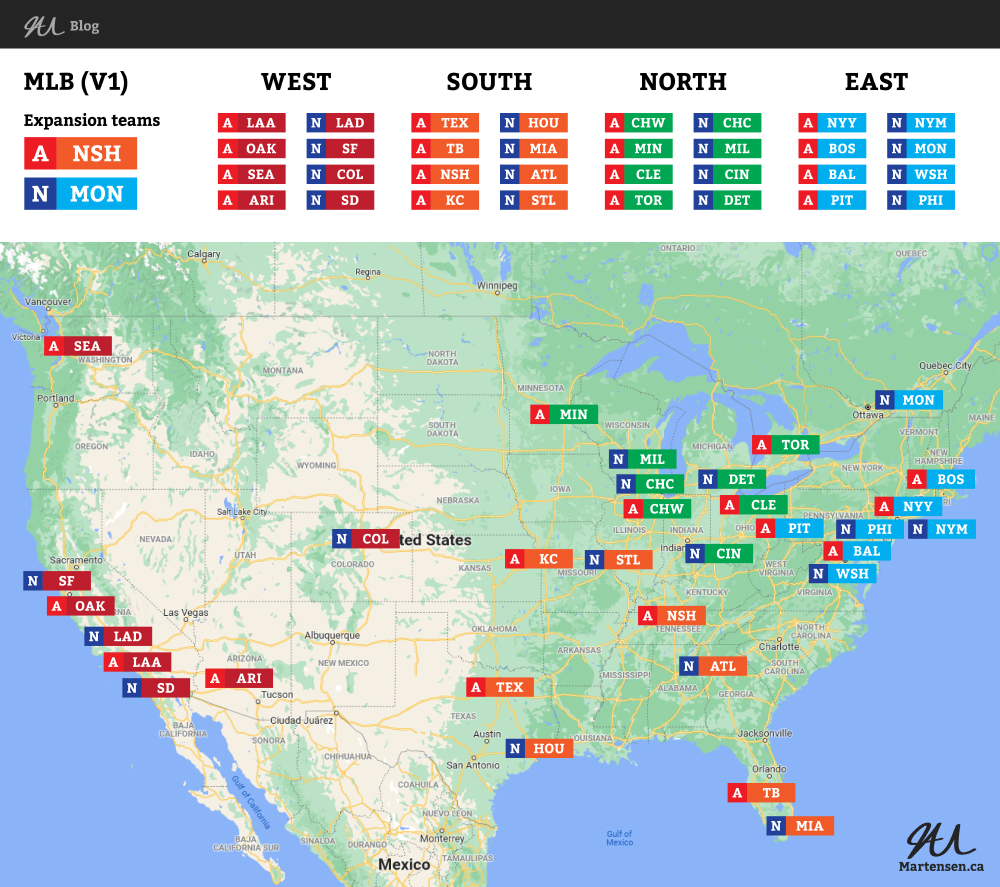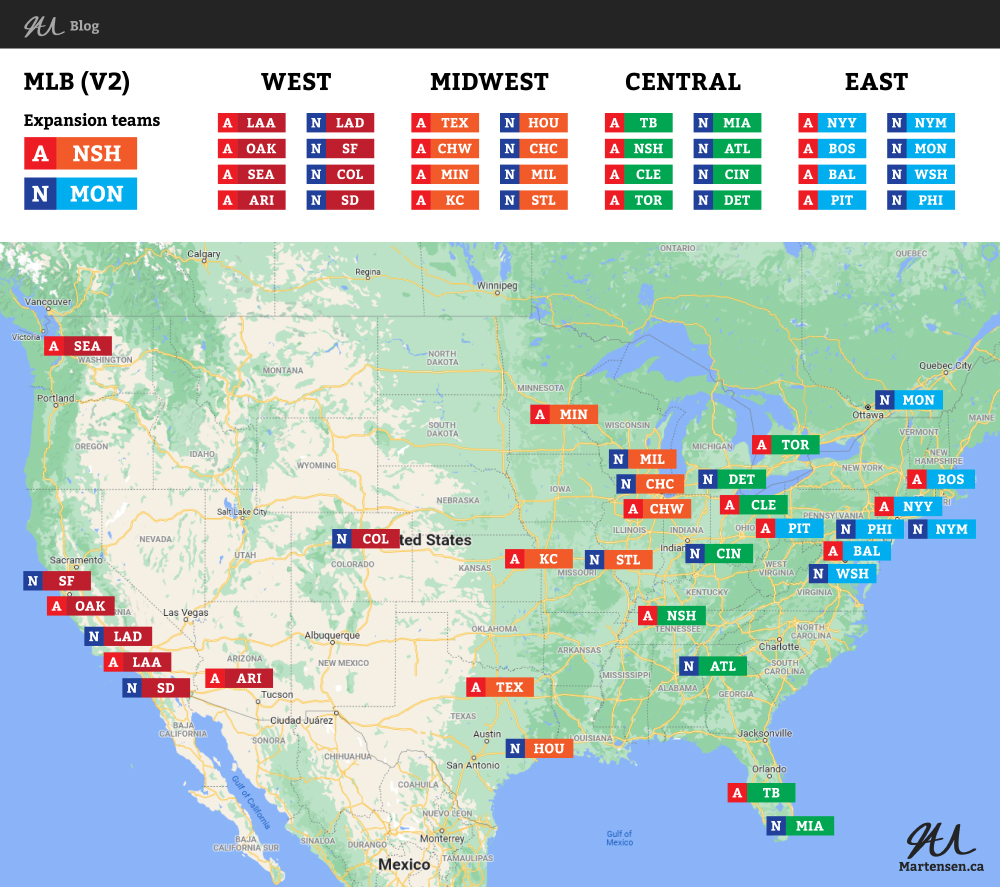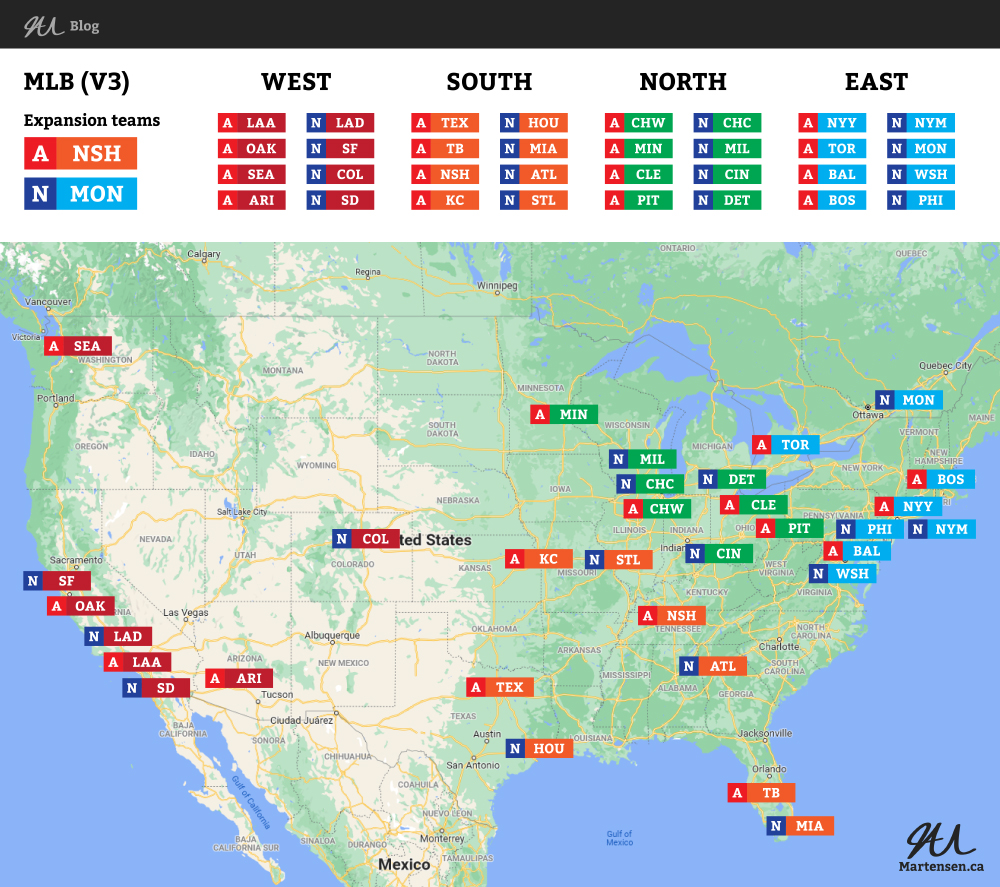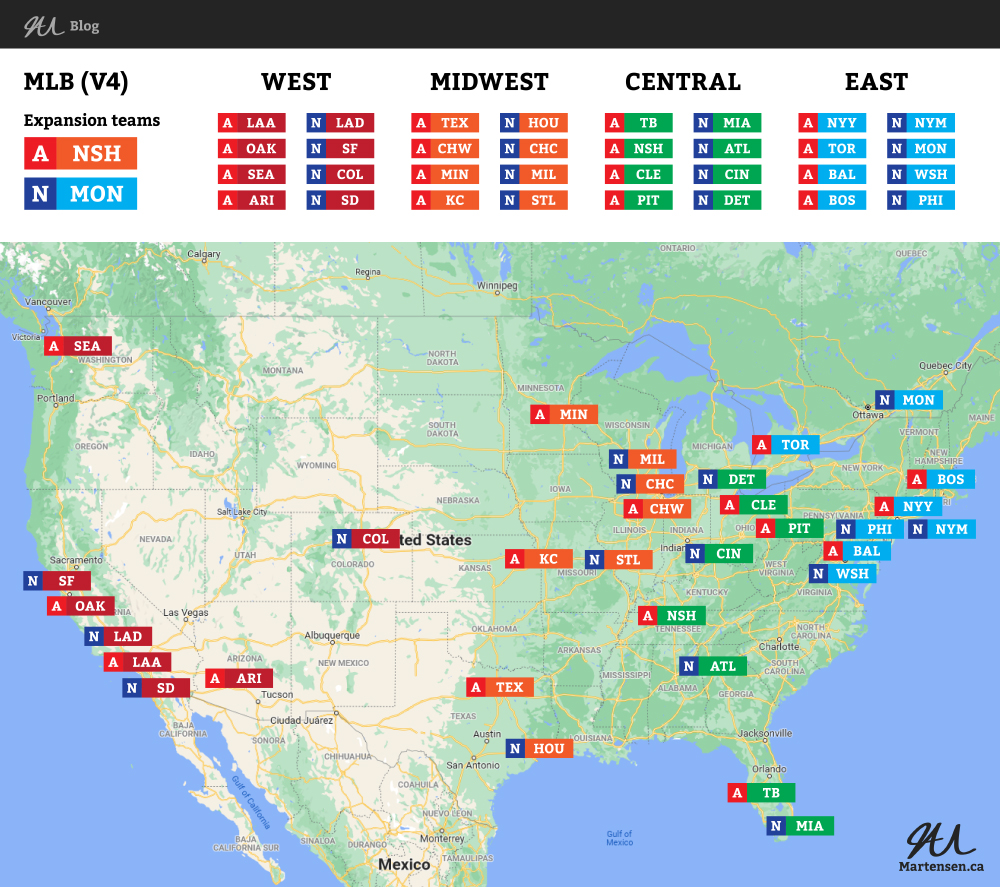
The best MLB expansion and realignment options
Expanding to 32 teams is inevitable, and as a result, division realignment will be necessary. Here are the best-case scenarios.
2022 / January 25 / 8:00 AM / Ottawa, ON
There are a handful of cities on the short list for MLB expansion, and at this point MLB expansion is inevitable. It's already entered the public conversation and MLB has all but confirmed it will happen—now it's just a matter of who will enter the league and when.
When MLB expands, division realignment will be necessary to ensure an equal distribution of teams.
Currently, there are 30 teams. Two leagues of 15, and three divisions of 5 within each. Assuming two new teams, one in each league, we would be left with two divisions of 5 and one division of 6 in each league.
It makes sense that we would like to redistribute the teams in order to keep an even layout—MLB moved the Houston Astros to the American League a decade ago to fix the 16/14 league split, which gave us the current 15/15 split—and 32 teams actually makes that pretty easy.
Two leagues of 16 teams, and within each four divisions of four teams.
The only issue at that point is how exactly to split the current divisions into the future divisions—which teams go where?
I started experimenting with different expansion options and realignment years ago, and what I came up with is still what I believe to be the best-case scenarios.
Because keeping long-standing rivalries in tact and keeping division assignment according to geography remains in the league's, and the teams', best interests, ideally both expansion teams will be on the eastern side of the continent—you'll see why by the time you're done with this post.
Three of the five cities currently at the top of the list for expansion (Charlotte, Las Vegas, Montreal, Nashville, and Portland, OR) fit our eastern qualification, and Montreal is probably first on the list given it has previously supported an MLB team (and the circumstances surrounding its removal are questionable).
Every city that has had an MLB team taken away from it either had another team to fall back on (ie. it was a two-or-more team city) or has eventually received another team—except Montreal. They also have a prominent and dedicated committee lobbying for a new team.
Charlotte and Nashville (the other two eastern teams) are in a similar situation relative to the other, as each is a quickly growing market with an existing minor league team—proof that the city has an existing baseball fanbase. They are also both geographically in a sweet spot where there is somewhat of a void of existing teams and where neither would seriously infringe on another team's current fanbase and market coverage.
Nashville seems to have the better shot at the moment. They are more prominent than Charlotte in expansion discussions and they, like Montreal, have an existing committee dedicated to lobbying for a team.
So, I've chosen Nashville over Charlotte, but they are essentially interchangeable for the purpose of this post.
Now, there are two versions of this thing that could work, and the difference between the two lays in whether, at the end of the day, the final decision for division assignment prioritizes geography or rivalries.
In my opinion, geography has a slight edge, as using that as the decision maker makes the end result a little cleaner. Here it is, the ideal expansion and realignment scenario:

That final decision I just mentioned, it was the decision to put Kansas City and St Louis into the South division of their respective leagues. I will show you what prioritizing rivalries (the Cardinals-Cubs rivalry, one of the top two or three rivalries in the sport) over geography would do to change the end result in a second.
You can see that this scenario creates divisions based on geography as naturally as possible—this scenario would generate the least travel distance for each team given a schedule that includes more games against same-division opponents, as is currently the case with MLB scheduling.
I have listed the teams above the map in a way that lays out each team's natural interleague opponent side-by-side.
To make this work Arizona would transfer to the AL, Houston would go back to the NL, Detroit would go to the NL, Pittsburgh would switch to the AL, Nashville would enter as an AL team, and Montreal would be back in the National League, where they were previously.
You can see how Charlotte replacing Nashville would have no effect—Charlotte is labeled on the map just east of Atlanta—they are both Atlanta's natural interleague rival and they can both fit into the same division.
Boston and Detroit having no natural geographical counterpart is the only hiccup. You could argue Boston and Montreal could pair up, and then Detroit and Toronto would pair up—which is how the divisions are laid out—but the Toronto-Montreal Canadian rivalry would certainly be more important to preserve over those two pairings.
Because neither Detroit nor Boston has a natural rival, it would make sense to pair them together rather than split up the Canadian rivalry just because Detroit and Boston are a little bit further apart than they would be to Toronto and Montreal, respectively.
So, I think the best-case scenario is to split the divisions based strictly on geography, as seen above, and then match up Toronto to Montreal and Boston to Detroit come time for interleague play.
Now, let's look at how preserving the Cardinals-Cubs rivalry would change division alignment:

Basically, we would take the middle two divisions and align them with a vertical split instead of a horizontal split. It still works pretty naturally, and only comes at the cost of a little bit more travel for each of these teams.
Although it was only a one-hour time difference, and therefore relatively insignificant to begin with, this scenario also eliminates cross-time zone play within those divisions with one lone exception—Nashville is the only Central time zone team in an otherwise Eastern time zone division. And if it were Charlotte entering the league instead of Nashville, that lone exception would vanish too.
However, being a Blue Jays fan, I would personally like to see Toronto remain in the East division to keep them in the same division as the Yankees and Red Sox. Being in the same division with those teams makes it tougher on the Blue Jays, but I wouldn't rather have it any other way. The AL East is a bloodbath, and frankly, I love it. If you were to call me sadistic because of that, I think that would be fair.
But, nonetheless, I would like to see it, so I have taken each of the two above scenarios and switched Toronto with Pittsburgh.

This makes the Pennsylvania interleague matchup a cross-divisional thing instead of within the confines of the two Eastern divisions, but now the Toronto-Montreal rivalry is purely Eastern-division based, so it evens out. Detroit would still play Boston as their interleague rivalry.
You can see it also has minimal impact on intra-division geography—it may not be 100% optimized but it is only a small difference.
Looking at the AL-NL assignments, you may ask why not just switch Detroit back to the AL and Pittsburgh back to the NL? That's where they are now and, in this scenario, they are both North teams so it is an easy switch (or non-switch)!
Well, then that means the Philadelphia-Pittsburgh and Boston-Detroit interleague matchups are gone—and given that the NL is almost certainly going to adopt the DH, the league assignments are moot in terms of on-field difference, so I would prefer to prioritize interleague rivalries for more satisfying balance.
Here's how switching Toronto and Pittsburgh would look in the scenario where the Cardinals-Cubs rivalry is preserved:

This is personally my favourite alignment—geography be damned. These are small changes from the geography-optimized alignment at the end of the day, they are nearly as satisfying in that respect, so if I were commissioner, V4 is the route I would take.
If I had to leave personal preference out of the decision, however, then V1 is the obvious choice for naturally occurring divisions.
Lastly, if the league were to expand one east team and one west team, instead of two east teams, then that would only create more headaches—it throws off geographical alignment because it would push Colorado into a more eastern division (they don't even really have a natural geographical position or rivalry to begin with), and that has a cascading effect as you continue to move east.
It would be better to expand two west teams rather than one of each—again, Portland and Las Vegas being the most likely choices—because they would fit nicely into the West divisions. It would give us Seattle-Portland and Arizona-Las Vegas natural rivalries, but it would also mean both Colorado and San Diego are the odd ones out, and again would create a cascading effect as you move east, again creating more headaches.
I don't think you need more proof at this point. A Montreal and Nashville/Charlotte expansion with any of the four division alignments I've shown above would be far and away the best-case scenarios.
I rest my case.
—James
